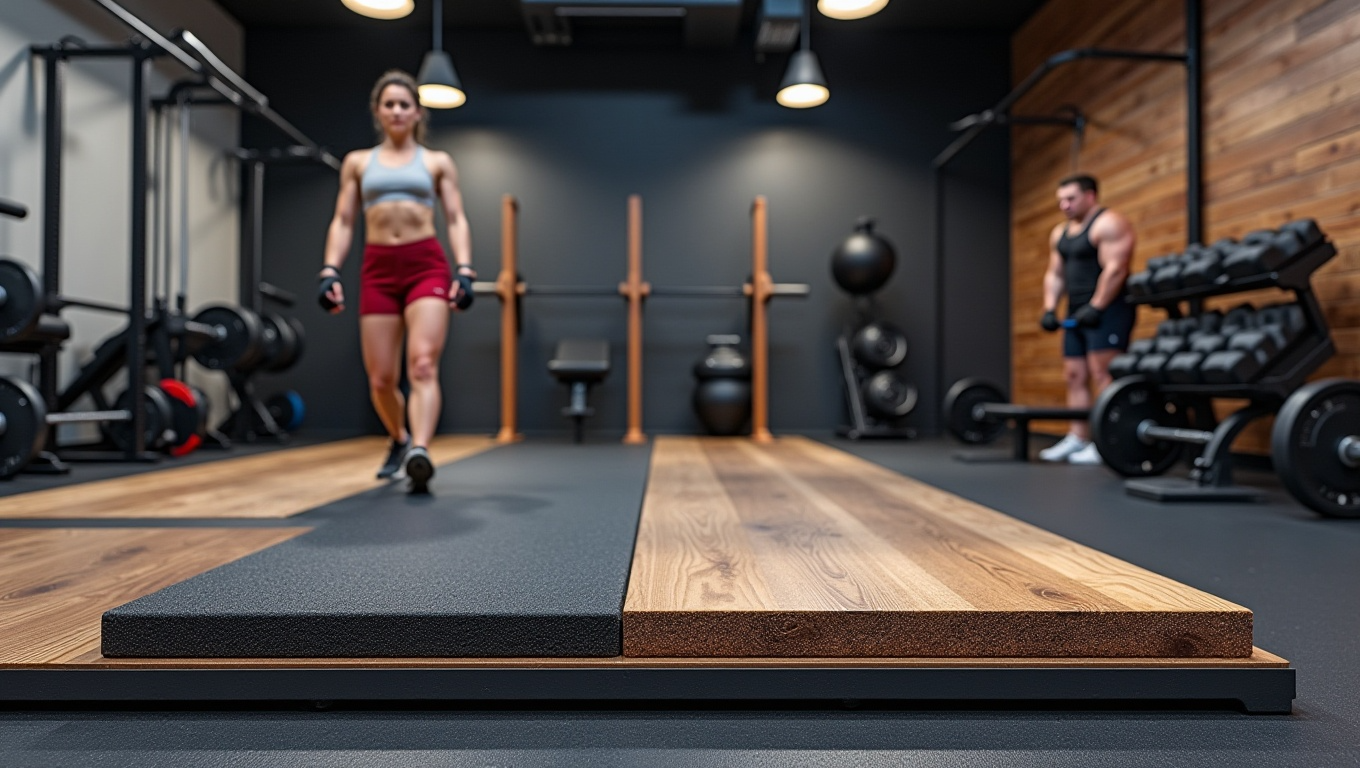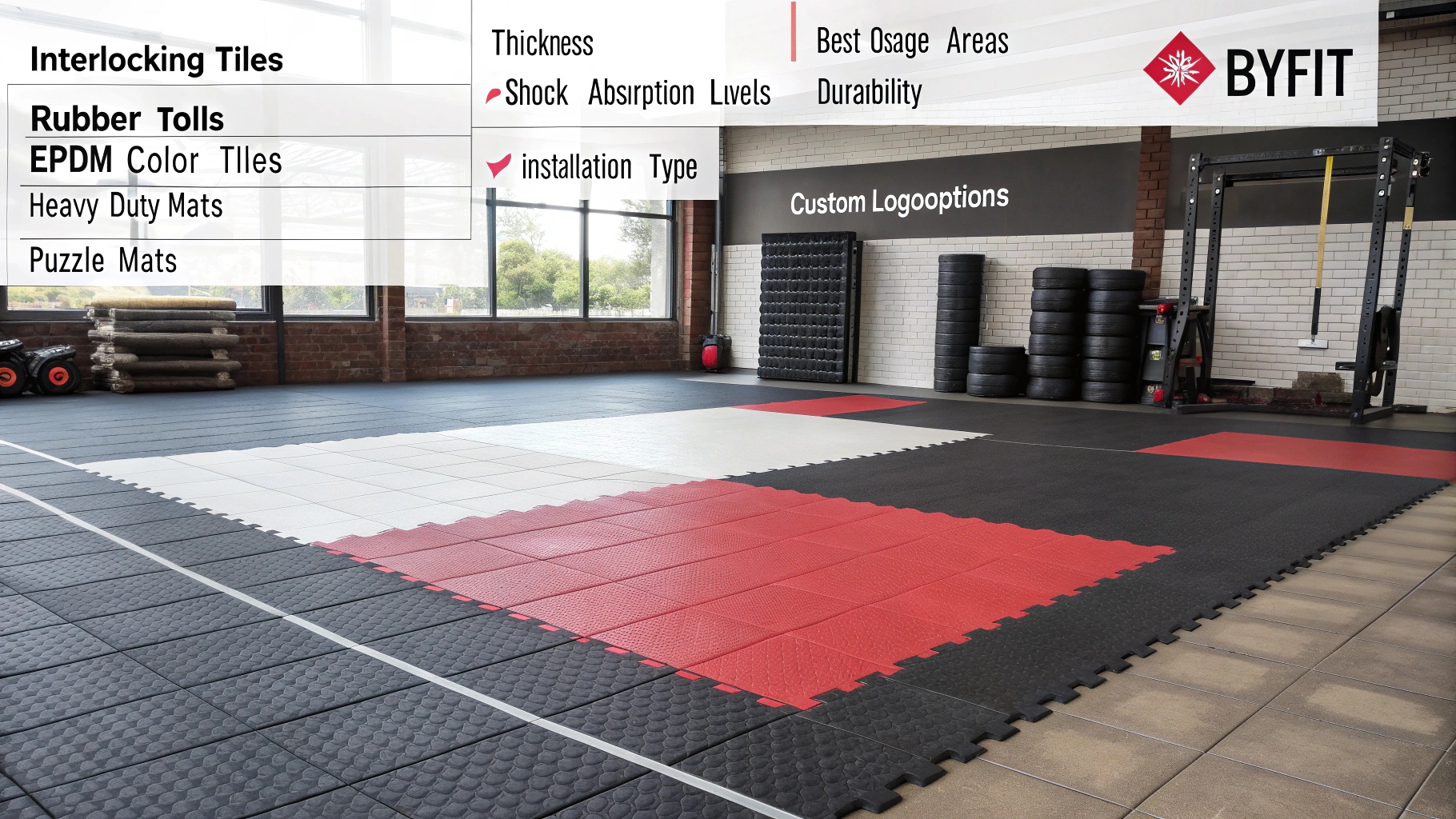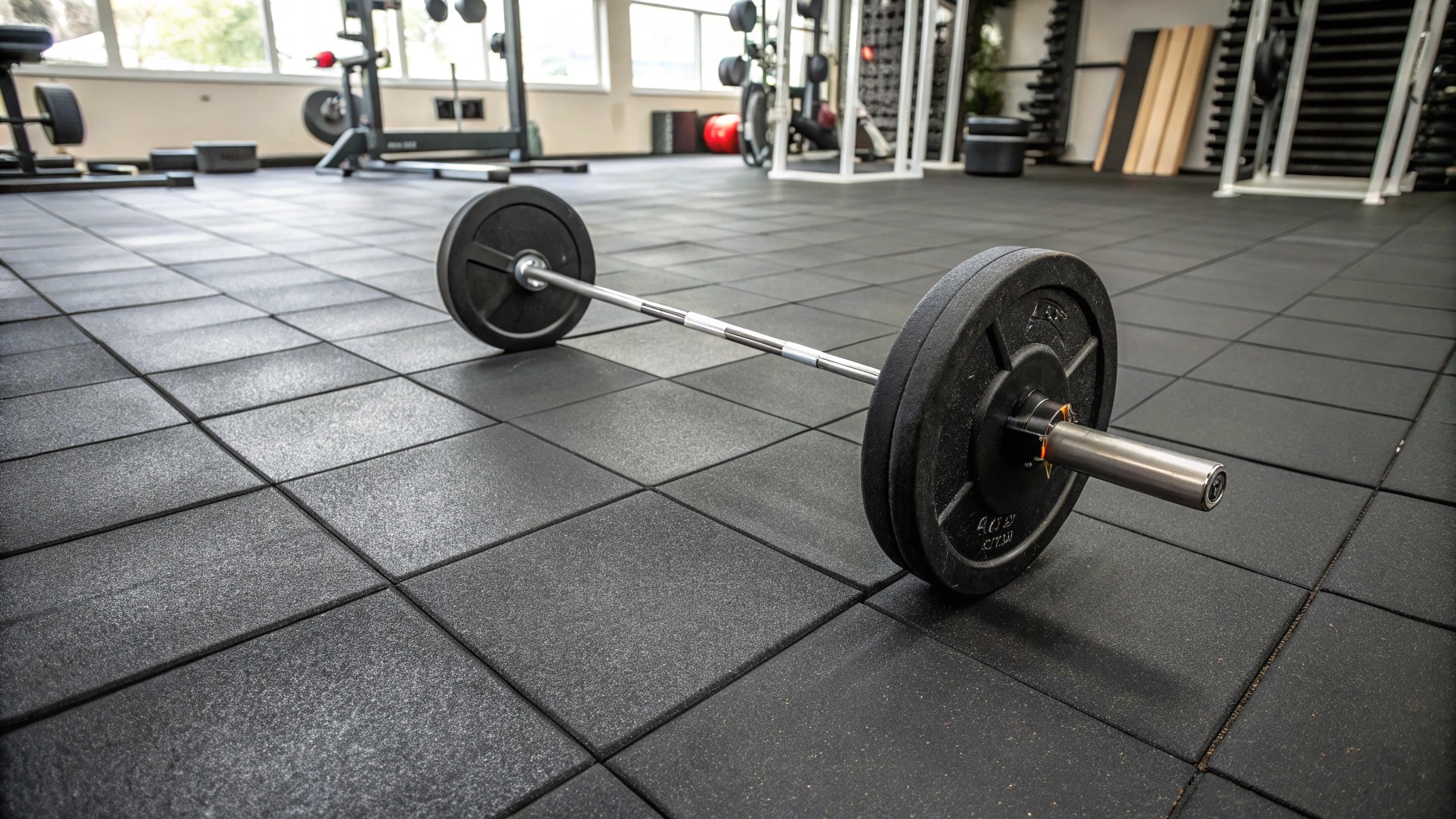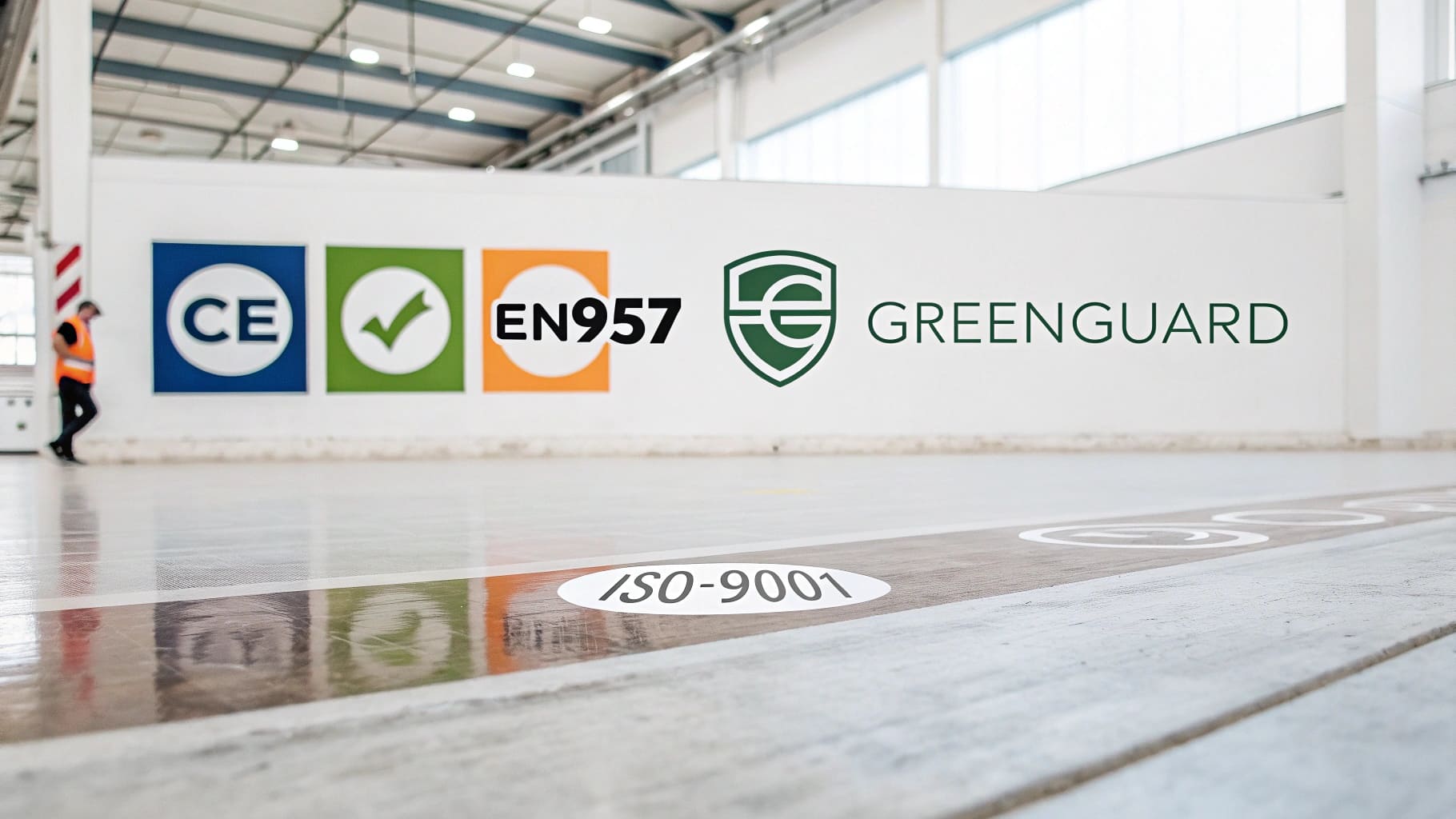Are you still bothered by being unsure how to choose gym flooring?Overwhelmed by the options and their pros and cons, unsure of what really works?
Gym mats primarily use rubber, EVA foam, and PVC. Rubber is favored for its durability, eco-friendliness, and slip resistance. EVA foam is a lighter, budget-friendly option, while PVC offers versatility but may raise environmental concerns.
 Gym Flooring Material Types
Gym Flooring Material Types
Choosing the right gym flooring can be a real challenge, but it is important! Let’s break it all down, so you can choose the right flooring for your business.
What are the common materials used in gym rubber flooring?
Worried about the materials in your gym flooring? Wondering if they’re safe, durable, and good for the planet?
Common gym rubber flooring materials1 include natural rubber, synthetic rubber (like SBR), and recycled rubber. These offer a good mix of durability and elasticity. Recycled rubber, in particular, stands out for its environmental benefits.
![![BYFIT gym rubber flooring materials, EPDM, SBR, Granules, Rubber. #byfitgear]](https://www.byfitgear.com/wp-content/uploads/2025/03/create-a-visually-appealing-infographic-explaining.jpg) common materials used in gym rubber flooring
common materials used in gym rubber flooring
Are rubber flooring materials environmentally friendly?
Concerned about making eco-friendly choices? It’s a valid worry, especially with so many products claiming to be "green."
Recycled rubber flooring is the top choice, made from used tires. This process helps reduce landfill waste, which is a big plus. Unlike PVC, recycled rubber2 doesn’t release harmful VOCs.
| Feature | Recycled Rubber | Virgin Rubber | PVC |
|---|---|---|---|
| Environmental Impact | Low | Medium | High |
| VOC Emission | Very Low | Low | Potentially High |
| Sustainability | High | Medium | Low |
BYFIT specializes in providing eco-friendly gym rubber flooring solutions, if you need, Pls contact us!
How durable are rubber-based gym mats compared to other materials?
Tired of gym flooring that wears out too fast? Feeling like you’re constantly replacing mats and tiles?
Rubber-based gym mats are much more durable than other options like EVA foam or PVC. They can handle heavy weights and constant use, so you are not replacing them all the time!
| Material | Durability | Resistance to Heavy Weights | Lifespan (Years) |
|---|---|---|---|
| Rubber | High | Excellent | 10-20 |
| EVA Foam | Low | Poor | 1-3 |
| PVC | Medium | Fair | 5-10 |
| Recycled Rubber | High | Excellent | 10-20 |
What material makes gym flooring slip-resistant?
Worried about slips and falls in your gym? It’s a common concern, safety should always come first!
Rubber’s natural elasticity provides excellent grip, even when wet. This reduces slip risks, especially when compared to materials like PVC or EVA foam.
| Material | Slip Resistance (Dry) | Slip Resistance (Wet) |
|---|---|---|
| Rubber | Excellent | Excellent |
| EVA Foam | Good | Fair |
| PVC | Fair | Poor |
What are the pros and cons of different gym flooring materials?
Confused by all the gym flooring choices? Don’t know which material will hold up, or which is the safest?
Rubber is the best choice for durability and safety, but it can be more expensive. EVA foam3 is cheaper and lighter, good for low-impact activities. PVC is adaptable but may have environmental problems.
](https://www.byfitgear.com/wp-content/uploads/2025/03/create-a-comparative-infographic-highlighting-the-.jpg) Pros of ByFit Rubber Flooring
Pros of ByFit Rubber Flooring
Let’s break down the pros and cons to help you make the right decision.
Why is EVA foam a popular alternative to rubber flooring?
Looking for a cheaper option than rubber? EVA foam seems like a good deal, but is it really right for your gym?
EVA foam is popular because it’s lightweight, affordable, and easy to install. It’s perfect for home gyms or areas with light use, providing basic cushioning and comfort.
| Feature | EVA Foam | Rubber Flooring |
|---|---|---|
| Cost | Lower | Higher |
| Weight | Lighter | Heavier |
| Durability | Lower | Higher |
| Impact | Lower | Higher |
| Use Cases | Home gyms, light use | Commercial gyms, heavy use |
| Installation | Easy | Easy to moderate |
Does PVC flooring emit harmful chemicals?
Concerned about air quality in your gym? It’s smart to think about what materials you’re using!
Some PVC flooring4 can emit volatile organic compounds (VOCs), which can affect indoor air quality. These chemicals can cause problems over time, like headaches or even long-term health issues.
| Flooring Type | VOC Emission | Potential Health Effects |
|---|---|---|
| PVC | High | Respiratory issues |
| Rubber | Low | Minimal |
| EVA Foam | Low | Minimal |
How does recycled rubber flooring5 compare in quality?
Thinking about recycled rubber but worried it won’t perform as well? It’s a common concern, but technology has come a long way!
Recycled rubber is just as good as new rubber. Thanks to modern manufacturing, it meets the same standards for durability and performance, with the added benefit of being eco-friendly.
| Attribute | Recycled Rubber | Virgin Rubber |
|---|---|---|
| Durability | High | High |
| Performance | Excellent | Excellent |
| Sustainability | High | Low |
| Cost | Often lower | Typically higher |
| Quality | Comparable to virgin rubber | Industry standard |
If you’re searching for reliable, high-quality gym rubber flooring, BYFIT is ready to assist.
What are the main types of gym rubber flooring?
Confused about the different types of rubber flooring? Don’t know whether to choose tiles, rolls, or something else?
The main types are interlocking rubber tiles6, rubber rolls7, and rubber mats. Tiles are easy to install and replace, rolls provide a seamless look, and mats are good for specific areas.
 main types of gym rubber flooring
main types of gym rubber flooring
Let’s explore these options and figure out what works best for your needs.
What is the difference between interlocking rubber tiles and rolls?
Choosing between tiles and rolls for your gym? It’s like picking between puzzle pieces and a big carpet, each has its own benefits.
Interlocking tiles are easy to install and replace, perfect for areas that change a lot. Rolls give a smooth, seamless surface, best for large, open spaces.
| Feature | Interlocking Rubber Tiles | Rubber Rolls |
|---|---|---|
| Installation | Easy, DIY-friendly | Requires some skill, may need professional help |
| Coverage | Modular, good for small or irregular spaces | Seamless, best for large, open areas |
| Replacement | Easy to replace individual tiles | More difficult to replace sections |
| Customization | Highly customizable, easy to change layouts | Less customizable, better for fixed designs |
| Seams | Visible seams between tiles | No seams, providing a smooth surface |
Are custom-shaped rubber mats available for specialized equipment areas?
Need flooring that fits perfectly around your unique equipment? Like a tailored suit, it has to be just right!
Custom-shaped rubber mats are available! These mats can be made to fit any specialized equipment or area, providing protection where standard shapes won’t work.
| Feature | Custom-Shaped Rubber Mats | Standard Rubber Mats |
|---|---|---|
| Fit | Tailored to specific areas | General fit for common areas |
| Equipment Compatibility | Perfect for unique setups | Suitable for standard setups |
| Design Flexibility | High | Limited |
| Installation | Easy, precise | Easy, general |
| Protection | Optimal for specific needs | Good for overall coverage |
BYFIT’s custom-shaped rubber mats8 can be a perfect match!
How thick should gym flooring mats be for maximum shock absorption?
Want to protect your athletes and your equipment? Thickness matters, it’s like having the right amount of padding!
For general fitness, 8mm thick mats work well. For high-impact activities like Olympic lifting, you need at least 15mm for safety and equipment protection.
| Activity | Recommended Thickness (mm) | Purpose |
|---|---|---|
| General Fitness | 8 | Basic cushioning, comfort |
| Weightlifting | 10-12 | Moderate impact absorption, equipment protection |
| High-Impact/CrossFit | 15+ | Maximum shock absorption, heavy equipment, athlete safety |
| Specialized Areas | Varies | Custom thickness based on specific equipment and usage needs |
Which gym flooring type suits different workout areas?
Struggling to find the right flooring for each area of your gym? It’s a common headache, different workouts need different support!
Rubber flooring is versatile, working well for almost any workout area. For high-impact zones like CrossFit, thicker rubber mats are best. For yoga or Pilates, something softer like EVA foam might be preferred.
 Which gym flooring type suits different workout areas
Which gym flooring type suits different workout areas
Let’s explore what works best where!
What flooring type is best for high-impact exercises like CrossFit?
Dealing with intense workouts like CrossFit? You need flooring that can take a beating and protect your athletes!
For CrossFit, thick rubber flooring is best. It absorbs the shock from heavy drops and high-impact movements, keeping everyone safe and the equipment in good shape.
| Flooring Type | Impact Absorption | Durability | Safety |
|---|---|---|---|
| Thick Rubber | Excellent | High | High |
| Standard Rubber | Good | Medium | Medium |
| EVA Foam | Fair | Low | Low |
| PVC | Poor | Medium | Low |
Can rubber mats be used outdoors near fitness equipment?
Thinking of setting up an outdoor workout area? Wondering if rubber mats can handle the weather?
Rubber mats can definitely be used outdoors! They are durable and weather-resistant, perfect for areas near fitness equipment exposed to the elements.
| Material | Weather Resistance | UV Resistance | Durability |
|---|---|---|---|
| Rubber | Excellent | Good | High |
| EVA Foam | Poor | Poor | Low |
| PVC | Fair | Fair | Medium |
Are modular rubber floors easy to install or remove?
Need flooring that’s simple to put down and pick up? If you like changing things up, you need something flexible!
Modular rubber floors9, especially interlocking tiles, are super easy to install and remove. You can rearrange them, replace sections, or move them to a new location.
| Flooring Type | Installation Ease | Removal Ease | Flexibility |
|---|---|---|---|
| Interlocking Tiles | Excellent | Excellent | High |
| Rubber Rolls | Moderate | Moderate | Medium |
| Glued-Down Rubber | Difficult | Difficult | Low |
Why choose rubber flooring over other gym flooring options?
Still on the fence about rubber flooring? Wondering if it’s really worth the investment compared to other options?
Rubber flooring is the best all-around choice. It’s durable, safe, reduces noise, and even looks good! It’s like the Swiss Army knife of gym flooring.
](https://www.byfitgear.com/wp-content/uploads/2025/03/BYFIT-Rubber-Flooring-The-Champions-Choice.jpeg) Why choose rubber flooring over other gym flooring options
Why choose rubber flooring over other gym flooring options
Let’s dive into why rubber might be the perfect fit for your gym.
How does rubber flooring prevent injuries during workouts?
Safety is the biggest concern, right? You want to keep everyone working out safe from slips, falls, and joint stress!
Rubber flooring prevents injuries by providing excellent slip resistance and shock absorption. It reduces the impact on joints, which is a huge help during intense workouts.
| Feature | Rubber Flooring | Other Flooring (e.g., Hardwood, Concrete) |
|---|---|---|
| Slip Resistance | High | Low |
| Shock Absorption | High | Low |
| Joint Impact | Reduced | High |
| Injury Prevention | Excellent | Poor |
Does rubber flooring reduce noise in gyms?
Tired of the constant clanging and banging in your gym? Noise can be a real problem, especially in a busy space!
Rubber flooring significantly reduces noise. Unlike hard surfaces like wood or concrete, rubber absorbs sound, creating a quieter, more enjoyable environment.
| Flooring Type | Noise Reduction | Sound Absorption |
|---|---|---|
| Rubber | High | Excellent |
| EVA Foam | Medium | Good |
| Hardwood | Low | Poor |
| Concrete | Very Low | Very Poor |
Reach out to BYFIT for solutions!
Can rubber flooring improve a gym’s overall aesthetic appeal?
Think gym flooring is just about function? It can actually make your space look better, too!
Rubber flooring comes in various colors and textures, and can even be customized with logos or designs. This not only improves safety and performance, but also upgrades the gym’s style.
| Flooring | Aesthetic Options | Customization | Visual Impact |
|---|---|---|---|
| Rubber | Colors, Textures, Patterns | Logos, Designs | High |
| EVA Foam | Limited Colors | Limited | Medium |
| Hardwood/PVC | Standard Designs | Low | Low |
What certifications prove the benefits of gym rubber flooring?
Confused about all the certifications for gym flooring? It’s like reading a foreign language, which ones really matter?
Key certifications, like ISO 9001, ensure consistent quality. Anti-slip ratings are important for safety, and shock absorption claims should be backed by ASTM or EN certifications.
 What certifications prove the benefits of gym rubber flooring
What certifications prove the benefits of gym rubber flooring
Let’s clarify what these certifications mean.
Are anti-slip ratings required for commercial gym flooring?
Worried about legal requirements for your gym? Safety standards are there for a reason, to protect your business and your clients!
Anti-slip ratings are often required for commercial gyms, to ensure safety. These ratings prove the flooring meets standards for preventing slips and falls.
| Certification | Description | Importance for Gyms |
|---|---|---|
| DIN 51130 | German standard for slip resistance | High (especially in wet areas) |
| ASTM C1028 | American standard for static coefficient of friction | High (general safety) |
| EN 13893 | European standard for slip resistance | High (EU compliance) |
| Pendulum Test Value | Measures slip potential | High (overall safety) |
Do certifications like ISO 9001 ensure durable rubber flooring?
Unsure what ISO 9001 really means for your flooring? It sounds official, but does it translate to quality?
ISO 9001 certification ensures the manufacturer follows consistent quality management systems. This means the rubber flooring is made to high standards, batch after batch.
| Certification | Focus | Benefit for Gym Flooring |
|---|---|---|
| ISO 9001 | Quality Management System | Consistent production quality, durability |
| ISO 14001 | Environmental Management System | Eco-friendly practices, reduced environmental impact |
| REACH | Chemical Regulation (EU) | Ensures flooring is free from harmful substances |
| RoHS | Restriction of Hazardous Substances | Limits use of certain hazardous materials in production |
Is there a guarantee for rubber flooring’s shock absorption claims?
Wondering if those shock absorption claims are real? You need proof that the flooring will actually protect your clients!
Shock absorption claims should be backed by specific certifications, like ASTM F2772 or EN 14904. These standards prove the flooring meets tested performance levels for impact reduction.
BYFIT’s rubber flooring meets all these tests.
| Certification | Testing Standard | What It Guarantees |
|---|---|---|
| ASTM F2772 | Standard Specification for Athletic Performance | Defines shock absorption, vertical deformation, and energy restitution |
| EN 14904 | Surfaces for Sports Areas | Specifies requirements for shock absorption, friction, and other performance traits |
| DIN 18032-2 | Sports Halls – Halls for Gymnastics, Games and Multi-Purpose Use | Includes standards for shock absorption and other safety features |
Conclusion
Choosing gym flooring means thinking about materials, types, and benefits. Rubber stands out for durability, safety, and versatility. Always check for the right certifications to make sure you’re getting a product that meets your needs!
-
Learn about the various materials used in gym rubber flooring and their unique properties for durability and safety. ↩
-
Explore the environmental advantages of recycled rubber flooring, including its low VOC emissions and sustainability benefits. ↩
-
Explore the advantages of EVA foam flooring, including its affordability and ease of installation, perfect for home gyms. ↩
-
Learn about the potential health risks associated with PVC flooring and how it affects indoor air quality. ↩
-
Discover the benefits of recycled rubber flooring, including its durability and eco-friendliness, making it a smart choice for gyms. ↩
-
Explore the advantages of interlocking rubber tiles, including ease of installation and customization, to find the best fit for your gym. ↩
-
Discover the seamless look and benefits of rubber rolls, ideal for large spaces, to enhance your gym’s aesthetic and functionality. ↩
-
Learn how custom-shaped rubber mats can provide tailored protection and fit for unique gym setups, ensuring optimal safety and performance. ↩
-
Discover the flexibility and ease of installation of modular rubber floors, perfect for dynamic gym setups. ↩


